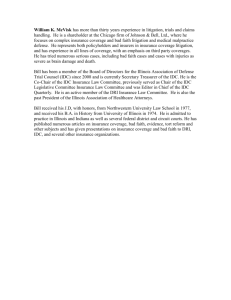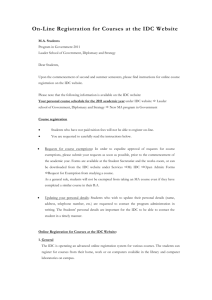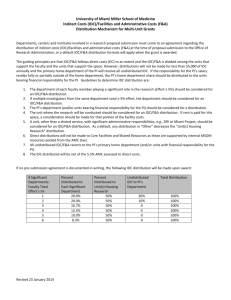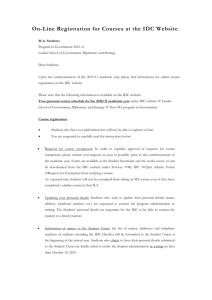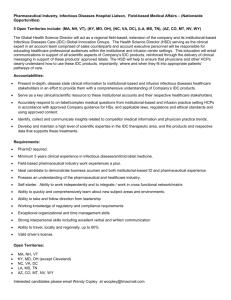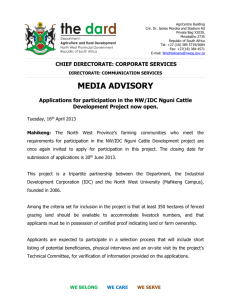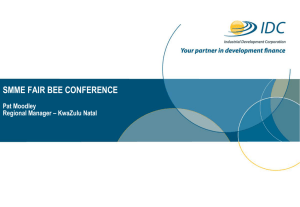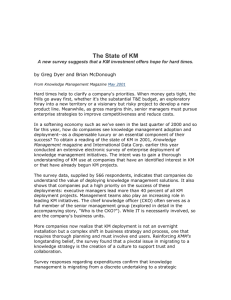Why Sticking with Windows XP Is a Bad Idea
advertisement
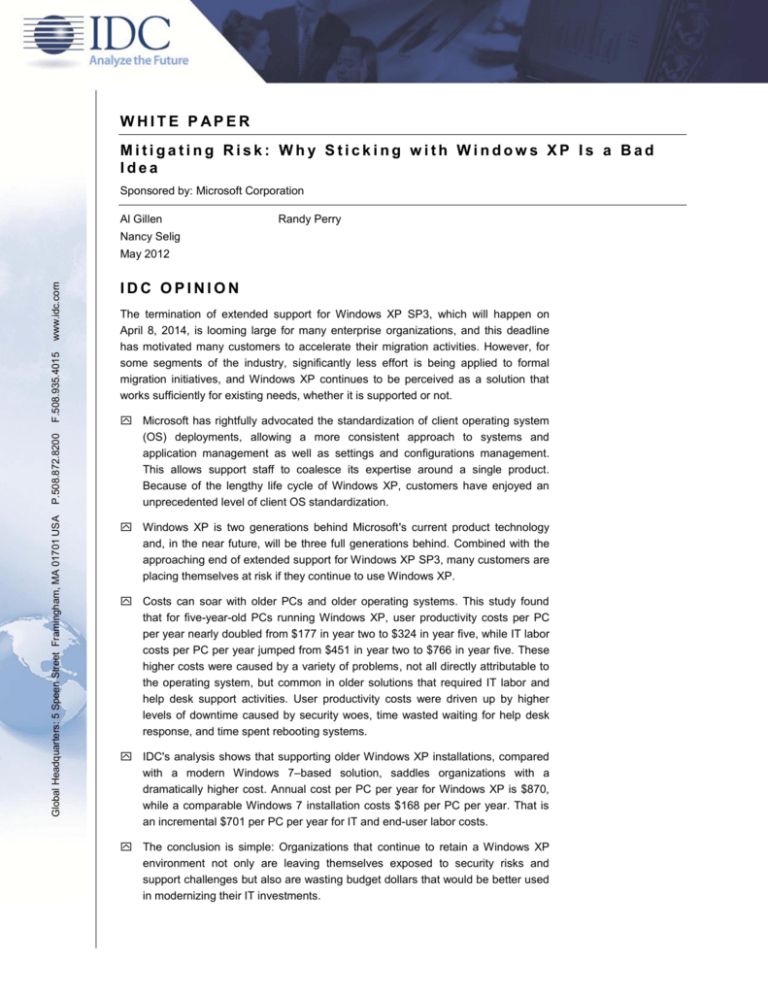
WHITE P APER Mitigating Risk: Why Sticking with Windows XP Is a Bad Idea Sponsored by: Microsoft Corporation Al Gillen Randy Perry Nancy Selig Global Headquarters: 5 Speen Street Framingham, MA 01701 USA P.508.872.8200 F.508.935.4015 www.idc.com May 2012 IDC OPINION The termination of extended support for Windows XP SP3, which will happen on April 8, 2014, is looming large for many enterprise organizations, and this deadline has motivated many customers to accelerate their migration activities. However, for some segments of the industry, significantly less effort is being applied to formal migration initiatives, and Windows XP continues to be perceived as a solution that works sufficiently for existing needs, whether it is supported or not. Microsoft has rightfully advocated the standardization of client operating system (OS) deployments, allowing a more consistent approach to systems and application management as well as settings and configurations management. This allows support staff to coalesce its expertise around a single product. Because of the lengthy life cycle of Windows XP, customers have enjoyed an unprecedented level of client OS standardization. Windows XP is two generations behind Microsoft's current product technology and, in the near future, will be three full generations behind. Combined with the approaching end of extended support for Windows XP SP3, many customers are placing themselves at risk if they continue to use Windows XP. Costs can soar with older PCs and older operating systems. This study found that for five-year-old PCs running Windows XP, user productivity costs per PC per year nearly doubled from $177 in year two to $324 in year five, while IT labor costs per PC per year jumped from $451 in year two to $766 in year five. These higher costs were caused by a variety of problems, not all directly attributable to the operating system, but common in older solutions that required IT labor and help desk support activities. User productivity costs were driven up by higher levels of downtime caused by security woes, time wasted waiting for help desk response, and time spent rebooting systems. IDC's analysis shows that supporting older Windows XP installations, compared with a modern Windows 7–based solution, saddles organizations with a dramatically higher cost. Annual cost per PC per year for Windows XP is $870, while a comparable Windows 7 installation costs $168 per PC per year. That is an incremental $701 per PC per year for IT and end-user labor costs. The conclusion is simple: Organizations that continue to retain a Windows XP environment not only are leaving themselves exposed to security risks and support challenges but also are wasting budget dollars that would be better used in modernizing their IT investments. METHODOLOGY IDC's standard methodology was employed for this project. All of the financial quantification is based on interviews with companies that have deployed both Windows XP and Windows 7. This study was built around in-depth interviews with nine end-user organizations that have deployed both Windows XP and Windows 7. These interviews were used in aggregate to quantify the financial risks of not migrating to Windows 7. IDC bases return-on-investment (ROI) calculations on standard, accepted definitions and calculations and the following assumptions: Time values are multiplied by burdened salary to quantify efficiency and manager productivity savings. Downtime values are a product of the reduction in downtime hours multiplied by the number of users affected and their hourly rate. Because not every hour of downtime equates to a lost hour of productivity, IDC specifically asks about the percentage impact of an hour of downtime and attributes a fraction of the hourly result to the dollar savings. All IT solutions require a deployment period. The full benefits of the solution are not available during deployment. To capture this reality, IDC prorates the benefits on a monthly basis based on the average deployment term. The net present value (NPV) of the three-year savings is calculated by subtracting the discounted three-year investment from the discounted three-year benefit. IDC uses an estimated discount rate to account for potential outlays made at the time of deployment and interest on that investment. Typically, companies use their cost of capital plus some risk factor. IN THIS WHITE P APER This IDC White Paper takes a deep look at the operational costs of Windows XP at large organizations and compares and contrasts those costs against operational costs associated with a current version of Windows — that being Windows 7 in every customer site interviewed for this study. This study takes into consideration both IT operational costs and selected end-user operational costs. The paper then aggregates the costs associated with ongoing support and maintenance and response to outages and hardware and software failures on the part of IT staff and calculates the ROI associated with the deployment of Windows 7 to replace aging Windows XP PCs. 2 #234690 ©2012 IDC SITUATION OVERVIEW Why It Is Time to Retire Windows XP IDC believes that the industry has hit a natural transition point, with both hard and soft cost justification to upgrade Windows XP installations with a Windows 7 solution. Some of the reasons are as follows: New PC capabilities that are not exploited by Windows XP. Most new PCs have features that were nonexistent, or immature, when service pack enhancements for Windows XP were discontinued. Today's PCs include features such as integrated WiFi and Bluetooth, faster USB ports, and high-resolution monitors and touchscreen capabilities. Many of these capabilities are either poorly supported or not supported by Windows XP Professional. Further, today, most PCs ship with a minimum of 4GB of memory, which a typical 32-bit Windows XP operating system is unable to address. A 64-bit install of Windows 7 allows full exploitation of that memory. The approaching end of Windows XP SP3 extended support on April 8, 2014. The termination of extended support means the end of security updates, (paid) hotfix agreement support, and paid per-incident support services. Lower operational costs. This paper introduces hard data on the support costs for Windows XP and compares those costs against the support costs for a more modern solution. Simply stated, older technology has a higher maintenance cost. This is exacerbated when organizations keep PCs in use for extended periods of time (beyond a typical three- to four-year life cycle). Soft benefits. The broad consumerization of IT that is sweeping across the industry has empowered end users and given them a louder voice in corporate IT decisions. It is likely that most consumers have experienced a modern user interface, whether it is Windows 7 or on one of the many rich consumer smart devices and tablets that are proliferating. IT departments that artificially hold users hostage aboard old technology solutions are setting the stage for a user revolt that could lead to a loss of influence by the IT department. By proactively encouraging the use of modern technology, the IT department is seen as being interested in improving the productivity of users. End users feel empowered to accomplish their jobs with modern tools that improve their productivity and eliminate wasted time resulting from poorly performing old technology, unnecessary application crashes, and operating system reboots. Compliance issues. Certain industry-specific regulatory requirements mandate that software be maintained and kept current with patches and fixes. The termination of Windows XP extended support means that organizations may find themselves out of compliance. ©2012 IDC #234690 3 The Windows Market Today Microsoft has been in command of the client operating system market for 20 years now. Despite several recent years of robust sales of Apple PCs, Microsoft still captures 9 out of every 10 client operating system sales in the industry on traditional x86 PC form factors. The bigger competition in the PC market continues to be a scenario of Microsoft working vigorously to replace older versions of Windows operating systems and related applications, including Microsoft Office. In recent years, the dynamics have focused on the deployment of Windows 7, displacing Windows XP and, in a minority of the cases, displacing Windows Vista. IDC research finds that Windows 7 adoption is going very well for Microsoft, and Windows 7 (and the successive product, Windows 8) is on a trajectory to capture the vast majority of new Windows deployments moving forward. However, shipment volume is only one dimension of the market dynamics, and to fully understand the challenge that Microsoft faces, one must consider the installed base view. Microsoft customers continue to have an enormous installed base of Windows XP operating systems. As of the end of 2011, Windows XP accounts for a remarkable 42% of the commercial (non-home use) Windows client operating environment installed base. Therein lies part of the problem that Microsoft and Microsoft's customers face given the approaching termination of Windows XP extended support. With the current trajectory, the Windows XP installed base will contract to 11% of paid commercial Windows client operating systems in use by the end of 2014. Windows 8 IDC has not yet broken out Windows 8 shipment projections from the current forecast totals. However, on traditional PC form factors (desktops, laptops), IDC does not expect to see any near-term acceleration to current commercial shipment forecasts associated with the release of Windows 8. IDC notes that traditional IT adoption and deployment cycles are preceded by a qualification and impact study associated with any new products, and any impact from Windows 8 on commercial deployments will not likely be felt before late 2013 or early 2014. In the interim, after the release of Windows 8, we expect to see customers exercising downgrade deployment rights with new PCs they acquire that come from OEMs preloaded with Windows 8, which is common adoption behavior among enterprise IT departments until they fully qualify and approve the use of a new product. 4 #234690 ©2012 IDC FUTURE OUTLOOK Study Demographics IDC conducted a study to assess the risk and the cost incurred by organizations that choose to extend their Windows XP life cycle rather than move forward to a current Microsoft product. For this study, we conducted in-depth interviews with nine organizations: four professional services firms, two educational organizations, and one organization each in construction, government, and petroleum production. They are large organizations with an average of 3,680 employees, 68 IT staff members, and 14 PC support staff specialists. In the case of the educational organizations, the number of PCs supported far exceeded the number of employees due to transient student populations. Among the study group, 90% of the end users were categorized as office workers (which includes students). Another 7% were classified as road warriors, including executive staff and sales professionals. An additional 3% were classified as work-from-home staff. In terms of hardware demographics, 54% are desktop users and 39% are laptop users, with the balance using a collection of other devices, including tablets and other smart devices. From a platform use perspective, over 90% of the devices in use within the study group are running Windows, with the overall total split between Windows 7 (65%) and Windows XP (29%). Four organizations were at 100% with Windows 7 aboard their Windows PCs, and two organizations were over 93% standardized on Windows XP. The Windows XP/Windows 7 Dilemma Today Anecdotal comments from IT professionals at these companies were indicative of the challenges and opportunities facing the industry. Justification for upgrading to Windows 7 cited by study participants includes: Support concerns: "We were concerned that XP would no longer be supported" Stability benefits: "Creating the most stable platform to give us the capability of doing offsite mobility much easier then we could have done with XP" Standardization: "We just wanted to standardize on one OS" Features of Windows 7: "The security is a lot better," "speed, reliability, flexibility, ease of use," "ability to virtualize apps," "capability of using DirectAccess as opposed to VPN apps" Yet customers that were not upgrading justified their position with adoption blockers that other customers are likely concerned with: Stability: "Windows XP has been relatively stable, people are happy, they are able to do their jobs ... no pressing need to force me to [upgrade]" Installed hardware: "We need newer hardware; these machines won't take Windows 7" Compatibility: "We are afraid that our apps won't be compatible" ©2012 IDC #234690 5 The Cost of Staying on Windows XP Figure 1 provides a convincing argument for the value associated with updating operating systems and replacing aging PCs. In particular, as systems pass the 3- to 3.2-year mark, costs begin to accelerate. IT labor costs jump by 25% during year four of ownership and an additional 29% in year five. User productivity costs suffer as well, with a 23% jump in year four and a 40% jump during year five. Comparing year five directly with year two indicates that combined IT labor costs and user productivity costs are a remarkable 73% higher. This paper explores these cost areas in more detail in the following sections. FIGURE 1 Support cost per PC per year ($) The High Cost of Supporting Older Systems 900 800 $766 700 600 500 400 $592 $451 $474 $324 300 200 $177 $188 $231 100 0 Year 2 IT labor costs Year 3 Year 4 Year 5 User productivity costs Source: IDC, 2012 IT Time Costs Table 1 provides a detailed look at the factors that add to the costs that are illustrated in Figure 1. There are two aspects to consider in Table 1: the absolute impact of any one IT productivity metric in terms of hours per PC per year and the magnitude of change that can be realized by moving to Windows 7. For example, patch management alone accounts for 49% of the operational activity investment required to continue supporting a Windows XP environment. Moving to Windows 7 will reduce the time invested in patch management by 82%. Considered another way, Windows XP requires over five times more hours per PC per year of patch management than Windows 7. Collectively, operational activity time required to support PCs shows a 70% reduction in terms of hours per PC per year for organizations that choose to replace their Windows XP systems with Windows 7. 6 #234690 ©2012 IDC TABLE 1 Annual IT Productivity Metrics (Hours per PC per Year) Metric Windows XP Windows 7 Change % Change Deploying/replacing PCs 0.33 0.11 0.22 66 Security-related activities 0.29 0.19 0.10 35 Maintaining images 0.30 0.13 0.17 57 Deploying applications 0.43 0.12 0.31 72 Patch management 1.5 0.3 1.2 82 User administration 0.20 0.07 0.13 64 Operational activities (subtotal) 3.0 0.9 2.1 70 Downtime 2.9 0.6 2.3 79 Help desk 4.8 0.8 4.0 84 Mitigating malware/viruses 0.60 0.06 0.54 90 Downtime-related activities (subtotal) 8.3 1.5 6.8 82 11.3 2.3 8.9 79 Total Source: IDC, 2012 The other dimension detailed in Table 1 is the impact of downtime and responding to problems that compromise a PC and require IT intervention to restore the system. The single largest component in downtime-related activities is the help desk operation, which accounts for 58% of the downtime-related time spent supporting Windows XP. Not far behind is resolving downtime issues, which accounts for 35% of the total time spent by IT in supporting Windows XP. Those metrics can be reduced by 79–84% through a move to Windows 7. ©2012 IDC #234690 7 When combined, all IT activities account for 11.3 hours of time spent per PC per year when using Windows XP. Shops that have moved to Windows 7 enjoy a far lower cost, spending 2.3 hours per PC per year on maintaining those systems. The cost of staying with Windows XP is the consumption of an additional 9 hours per PC per year. One way to rationalize the magnitude of the impact of that high support cost is that for every 230 PCs an organization supports, the equivalent of one additional full-time resource (40 hours per week) is required to maintain Windows XP. A move to Windows 7 frees up an equal number of hours, and for every 230 PCs an organization upgrades to Windows 7, one full-time equivalent of staff time is freed up to work on other projects that bring direct value to the business. End-User Time Costs One area that can easily be overlooked by IT departments is the rest of the cost to the business — the impact of problems on end users. Any end user can relate to the frustration at having a compromised system — whether it is because of a virus infection, some instability that builds up over time, or in other cases, an accidental self-inflicted problem caused by users tinkering with their system settings and configurations. Regardless of the cause, the result is the same: Users are unable to do their jobs, and the IT team has to come to the rescue. Table 2 highlights the cost areas that affect end users. One of the two key areas that most impact end users is the time spent waiting for the help desk to respond to and mitigate a problem users experience. This area alone accounts for over half of the annual productive time users lose when working on a Windows XP PC. The other area is reboot time, which accounts for 28% of the hours per PC per year that end users lose. Together, those two areas account for 80% of users' lost time. TABLE 2 Annual User Productivity Metrics (Hours per PC per Year) Metric Windows XP Windows 7 Change % Change Time lost to virus or malware attacks 0.6 0.1 0.5 90 Time lost to reimage a PC (result of virus/malware attacks) 0.01 0.00 0.01 87 Time lost for reboot 2.5 0.2 2.3 94 Downtime 1.1 0.2 0.9 83 Help desk 4.8 0.8 4.0 84 Total 9.0 1.2 7.8 87 Source: IDC, 2012 8 #234690 ©2012 IDC For users that have upgraded to a Windows 7 PC, time lost to reboots is virtually eliminated through a 94% reduction. In addition, because Windows 7 tends to be more stable and less prone to compromise, the time lost waiting for help desk response is reduced dramatically, with Windows 7 leading to under an hour of time per PC per year for end users. Overall, user productivity is dramatically boosted by Windows 7, while Windows XP users are saddled with 7.8 additional hours of lost time per year compared with their colleagues using Windows 7. Key Performance Indicators Table 3 presents key performance indicators that IT departments will experience when supporting their existing Windows XP environments compared with a Windows 7 alternative. TABLE 3 User Productivity Key Performance Indicators Key Performance Indicator (KPI) Windows XP Windows 7 Change % Change 84 67 17 20 Mean time to repair (minutes) 222 24 198 89 Time lost to virus or malware attacks per year (hours) 0.6 0.1 0.5 90 Number of reboots per month 5.4 0.7 4.6 86 Average time per reboot (minutes) 4.1 1.4 2.7 66 Time lost for reboot (hours) 2.5 0.2 2.3 94 Failure rate (%) 3.0 1.0 2.0 55 Downtime hours per year 1.1 0.2 0.9 83 Number of virus or malware attacks per month Note: Some KPI metrics are cited in minutes, while others are cited in hours or per month. Source: IDC, 2012 ROI AN ALYSIS IDC uses a discounted cash flow methodology to calculate the ROI and payback period. ROI is the ratio of the NPV and discounted investment. Payback period is the point at which cumulative benefits equal the initial investment. Table 4 presents IDC's ROI analysis for the deployment of Windows 7 to replace an older Windows XP installation. This ROI analysis constitutes a three-year view of the payback associated with a move from Windows XP to Windows 7. ©2012 IDC #234690 9 As shown in Table 4, organizations spent an average of $712 (discounted) per PC to replace each Windows XP (including hardware and software) and saved $1,685 (discounted) per PC in reduced IT labor support and lost productivity over three years. The payback period for a new deployment of Windows 7 is calculated at 12 months. The migration from Windows XP to Windows 7 yields a 137% return on investment over a three-year period. TABLE 4 Three-Year ROI Analysis Benefit (discounted) $1,685 Investment (discounted) $712 NPV $973 ROI 137% Payback period 12 months Discount rate 12% Source: IDC, 2012 Figure 2 presents the outcome of the ROI analysis in graphical form. The initial investment includes the average total costs for a fully loaded PC with Windows 7 offset by the cost to replace the PCs as part of the average replacement cycle (3.4 years). Annual benefits include reduced IT labor support and lost productivity. 10 #234690 ©2012 IDC FIGURE 2 ROI Analysis 2,000 $1,392 1,500 1,000 $691 $300 ($) 500 $25 0 -500 -1,000 ($1,012) -1,500 Initial year Year 1 Year 2 Year 3 Investment — Windows 7 Avoided replacement of Windows XP Net savings Source: IDC, 2012 CHALLENGES/OPPORTUNI TIES Any organization considering a move to a new operating system must take into account both the challenges and the opportunities. Some key considerations are as follows: Challenge: It takes money to save money. For organizations to embark on an upgrade cycle to replace Windows XP with Windows 7 requires confidence and commitment to take on capital expense (capex) with the presumption that there will be an operational expense (opex) that returns on that capex investment. While this study shows a clear benefit and a measurable ROI, for many organizations, capex costs are far easier to identify and measure than opex cost reductions. Opportunity: Cost savings are forever. Once an upgrade is completed, and the operational costs are lowered, those lower operational cost benefits continue to accrue into the future with no further direct capex investment. ©2012 IDC #234690 11 Challenge: Potential compatibility concerns. This study specifically evaluates the benefit of replacing Windows XP with Windows 7. However, application upgrades (or at least application compatibility mitigation) may be required as part of the upgrade process. This ROI analysis does not allow for applications that must be replaced. Opportunity: Well positioned for the future. Making a move to Windows 7 now means that organizations are well positioned to embrace Windows 8 aboard new hardware form factors that will leverage the Windows 8 Metro user interface. Over time, there may be justification to upgrade Windows 7 PCs with Windows 8, and all indications at this time are that the move from Windows 7 to Windows 8 will be seamless for applications and nonimpactful to existing hardware. Opportunity: Standardization. The ability to bring all PCs to a common, modern operating system leads to greater satisfaction among users and IT professionals as well as the ability to leverage cutting-edge applications, improve manageability, and reduce security risks thanks to features such as User Account Control, Internet Explorer 9, AppLocker, BitLocker, and other features designed to improve overall security. CONCLUSION This IDC White Paper shows clear benefit associated with a move from Windows XP to Windows 7 and presents a case for the many reasons why remaining with Windows XP is no longer a good business decision. Costs tend to soar when older products are used beyond their intended life cycle, and IDC research has clearly confirmed that trend. Benefits include the ability to reduce operational costs and avoid the need to hire additional support personnel as well as the opportunity to help users be more productive and happy in their daily work environments. The April 8, 2014, termination of extended support for Windows XP SP3 is a firm, impactful deadline that should be a real wake-up call for organizations of all sizes, but especially for midsize and large customers. Given the age of Windows XP, which is now two generations behind Microsoft's current product technology, the time has come for customers to realistically consider that they are placing their businesses at risk by continuing to utilize Windows XP. Organizations that continue to retain a Windows XP environment not only are leaving themselves exposed to security risks and support challenges but also are wasting budget dollars that would be better used in modernizing their IT investments. Copyright Notice External Publication of IDC Information and Data — Any IDC information that is to be used in advertising, press releases, or promotional materials requires prior written approval from the appropriate IDC Vice President or Country Manager. A draft of the proposed document should accompany any such request. IDC reserves the right to deny approval of external usage for any reason. Copyright 2012 IDC. Reproduction without written permission is completely forbidden. 12 #234690 ©2012 IDC
